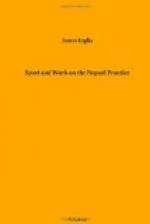Another caution should be observed. Never fire down the line. It is astonishing how little will divert a bullet, and a careless shot is worse than a dozen charging tigers. If a tiger does break back, let him get well away behind the line, and then blaze at him as hard as you like. It is particularly unpleasant to hear a bullet come singing and booming down the line from some excited dunderhead on the far left or right.
A tiger slouching along in front moves pretty fast, in a silent swinging trot; the tops of the reeds or grass sway very gently, with a wavering, side to side motion. A pig rushes boldly through, and a deer will cause the grass to rock violently to and fro. A buffalo or rhinoceros is known at once by the crashing of the dry stalks, as his huge frame plunges along; but the tiger can never be mistaken. When that gentle, undulating, noiseless motion is once seen, be ready with your trusty gun, and remove not your eye from the spot, for the mighty robber of the jungle is before you.
CHAPTER XXI.
Howdahs and howdah-ropes.—Mussulman custom.—Killing animals for food.—Mysterious appearance of natives when an animal is killed. —Fastening dead tigers to the pad.—Present mode wants improving. —Incident illustrative of this.—Dangerous to go close to wounded tigers.—Examples.—Footprints of tigers.—Call of the tiger.—Natives and their powers of description.—How to beat successfully for tiger. —Description of a beat.—Disputes among the shooters.—Awarding tigers.—Cutting open the tiger.—Native idea about the liver of the tiger.—Signs of a tiger’s presence in the jungle.—Vultures.—Do they scent their quarry or view it?—A vulture carrion feast.
The best howdahs are light, single-seated ones, with strong, light frames of wood and cane-work, and a moveable seat with a leather strap, adjustable to any length, on which to lean back. They should have a strong iron rail all round the top, covered with leather, with convenient grooves to receive the barrels of the guns, as they rest in front, ready to either hand. In front there should be compartments for different kinds of cartridges; and pockets and lockers under the seat, and at the back, or wherever there is room. Outside should be a strong iron step, to get out and in by easily, and a strong iron ring, through which to pass the rope that binds the howdah to the elephant.
You cannot be too careful with your howdah ropes. A chain is generally used as an auxiliary to the rope, which should be of cotton, strong and well twisted, and should be overhauled daily, to see that there is no chafing. It is passed round the foot-bars of the howdah, and several times round the belly of the elephant.




